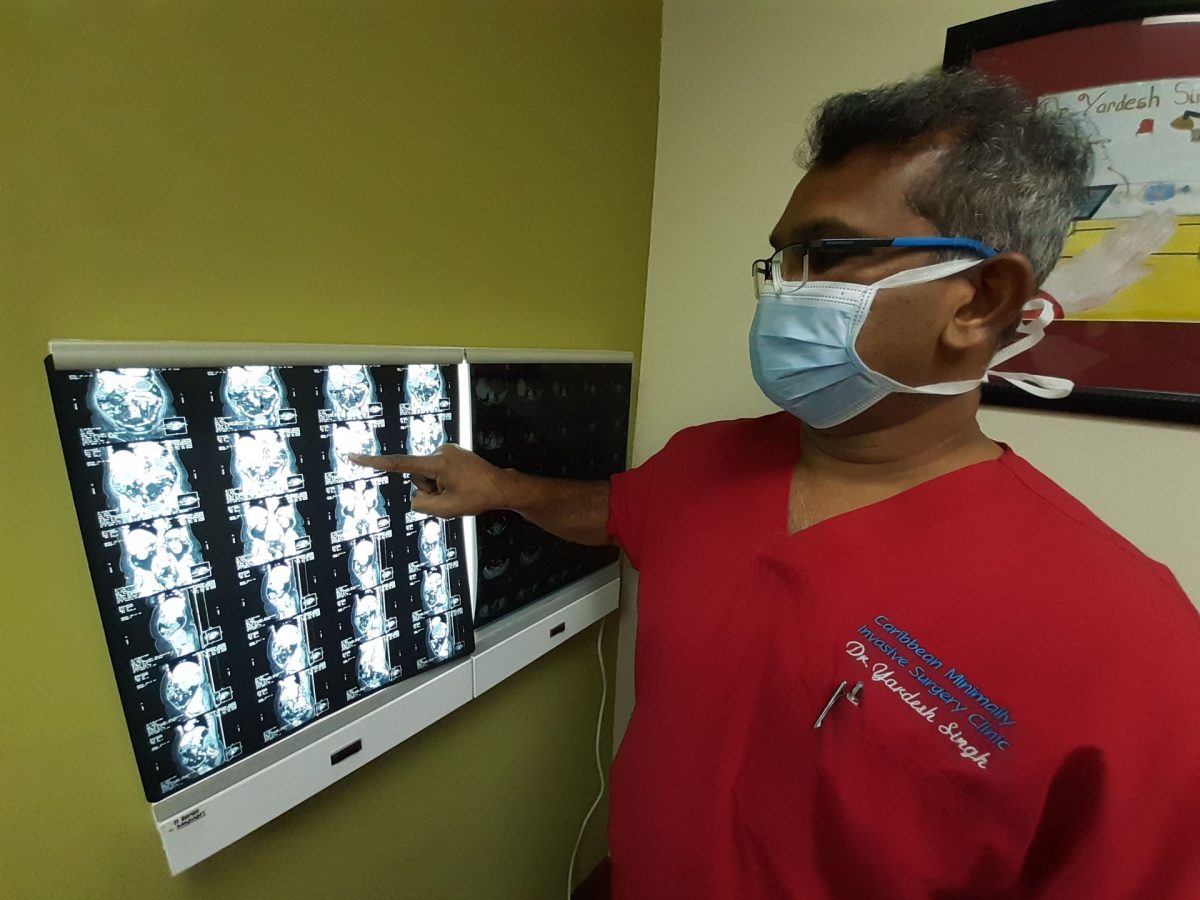(Trinidad Guardian) Imagine living with a gallstone the size of a large avocado in your abdomen, causing nausea and severe pain every time your body tries to process fatty foods.
It was the case for a 72-year-old woman in South Trinidad back in 2018. When the woman went to the Caribbean Minimally Invasive Surgery Clinic at the Southern Medical Clinic in San Fernando, CT scans showed that her gallstone measured at 14 cm x 7 cm.
Her unfortunate situation though led T&T to another star on the map as her surgical intervention is now among international publications on the Cureus Medical Journal as the world’s largest gallstone removal done laparoscopically.
Surgeons removed the gallstone through her navel.
The authors of the paper include Dr Yardesh Singh, Sidiyq Mohammed, Aqilah Hosein, Kercheval Ramoutar and Prof Vijay Naraynsingh.
Gallstones develop because of an imbalance in the chemical make-up of bile inside the gallbladder. A diet high in fatty foods can lead to unsustainable levels of cholesterol in bile. When this becomes too high, the excess cholesterol forms into stones.
Traditionally, large gallstones average around .5 cm, but in rare cases, they can grow to over 5 cm. For large gallstones, surgeons opt to perform an open or classical cholecystectomy.
But after examining the women’s scans, Singh, an Advanced Laparoscopic Surgeon, realised that he could remove the stone via a laparoscopic cholecystectomy.
“She visited other surgeons, and they actually wanted to do the traditional open surgery for her, which means that they would have to cut at least a 25 cm cut on the abdomen to remove this stone. However, after looking at the scan, I told her I would have been able to do this laparoscopically,” Singh told Guardian Media at his office yesterday.
Surgeons perform laparoscopic surgery using incisions the size of a keyhole. They use high tech tools, including a camera which they insert into your abdomen.
There are many advantages of laparoscopic surgery, including less post-operative pain.
Because the surgery was done through the woman’s navel, there was no visible scarring on the abdomen. There is also less blood loss during the procedure and the recovery time is shorter.
“Actually about two hours after the operation, she was able to have something to eat, walkabout and use the washroom. However, I am a very cautious person, and because of her age, I kept her overnight, and I sent her home the next day.”
Singh said he removed gallstone 5 cm and 6 cm long, but it was only after the surgery, he realised the feat his team completed.
The largest gallstone removal using classical cholecystectomy was 16.8 cm long, but his achievement was done without having to cut open his patient.
Singh said the woman was actually diagnosed with the gallstone about 30 years before she came to him. With little to no discomfort, the woman continued her life with the stone, and in 2018, it grew to an unbearable and painful size.
Surgical intervention was the only solution.
While surgery can be frightening and expensive, the woman’s circumstances put T&T on the map.
According to the paper published in the journal, surgeons operated for approximately 67 minutes using standard port placement. The decisions taken during the procedure proved beneficial as the women had an uneventful postoperative course which led to her discharge on the following day.
The paper stated: “A 12.8 cm x 7 cm gallstone was found within this huge gallbladder, which seems to be the largest gallstone to be removed laparoscopically in the world. While Xu et al. detailed the laparoscopic retrieval of a 9.5-cm gallstone, and Becerra et al. reported removal of a 16.8-cm long gallstone via classical cholecystectomy in the emergency setting, from the literature to date, our gallstone appears to be the largest removed laparoscopically.”
Common symptoms of gallstones are nausea and pain in the abdomen, back and shoulders. Singh said it is common in women around 40 years and older. Patients with sickle-cell, high cholesterol, hormonal imbalances and obesity are more likely to develop gallstones.
The preventative measure is simple: eat healthily and maintain a weight within your Body Mass Index.
As for the publishing of the paper, Singh received many kudos from senior colleagues and mentors in the medical community.
He said it would also help to bolster the public’s confidence in local medics.
As a post-graduate trainer at the University of the West Indies, St Augustine Campus, he is working with young doctors to improve the craft of minimally invasive surgeries.






